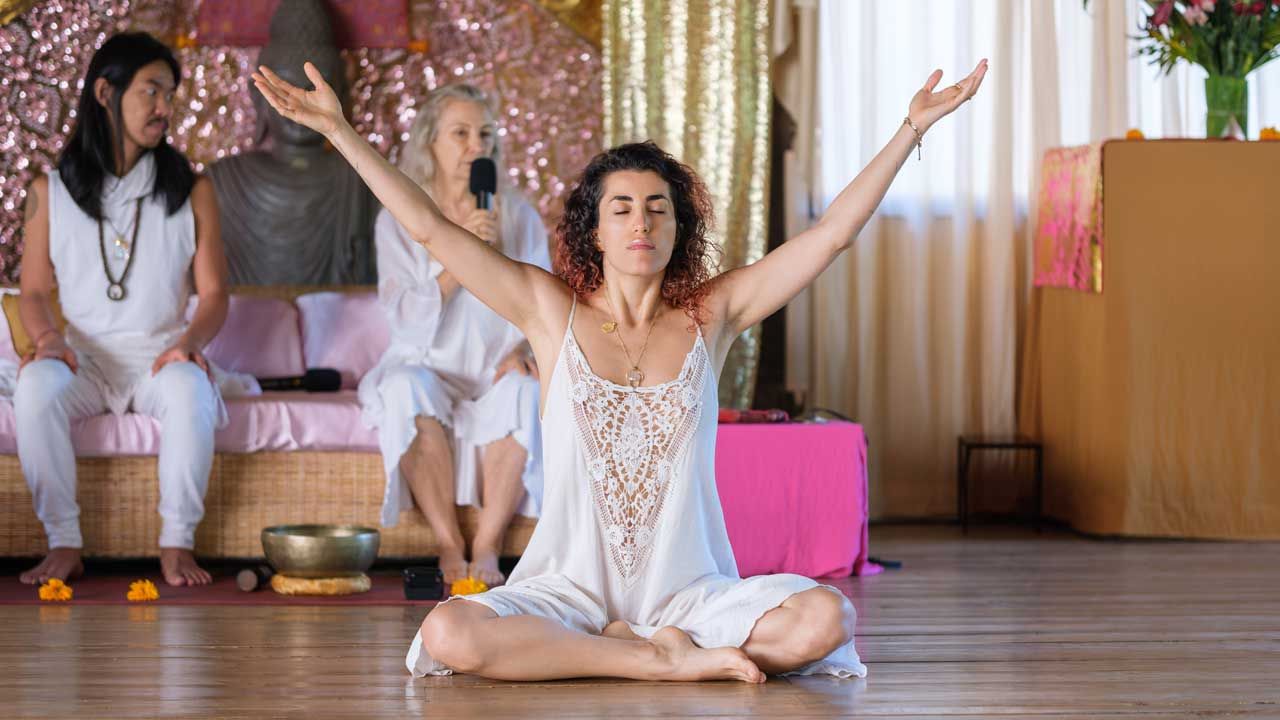A Practical Guide to 8 Limb Yoga and What It Really Means
May 30, 2025
I often feel that mainstream yoga has done a disservice. It’s boiled down an ancient system of liberation into curated Instagram posts and a never-ending pursuit of the “perfect” handstand. It’s become all about the body, how it looks, how it bends, how it performs, while quietly stripping away the depth and the raw transformative power of what yoga was designed to be.
The Eight Limbs of Yoga, as outlined by Patanjali, were built as a blueprint for liberation, a map out of the cycles of stress and surface-level validation that so many of us are trapped in.
The Eight Limbs offer a complete, multidimensional path to reclaiming your life. They guide you from the external world of action and appearance into the internal world of self-mastery and deep presence.
What are The 8 Limbs of Yoga?
Mainstream yoga often stops at the asanas, the physical postures. It treats yoga as a workout, something to strengthen the body, maybe calm the mind for an hour before heading back into the chaos. It sells yoga as a commodity, something to “do” rather than a way to be.
The Eight Limbs of Yoga start by asking hard questions:
- How do you show up in the world? (Yamas)
- How do you cultivate yourself internally? (Niyamas)
- Are you fully in your body, present, and alive? (Asana)
- Can you master your life force, regulate your energy, and find stillness? (Pranayama)
- Can you pull your senses inward, away from distraction, and tune into your deeper self? (Pratyahara)
- Can you hold focus, even when life gets chaotic? (Dharana)
- Can you sit with yourself, in full presence, beyond the noise? (Dhyana)
- And, eventually, can you dissolve the boundaries between you and the universe? (Samadhi)
1. Yama: Ethical Foundations for Living in the World

The five yamas are the ethical foundation of yoga, offering a blueprint for conscious living. They’re your personal recalibration system, the energetic detox that clears out the noise of conditioning, self-sabotage, and unconscious habits.
The word yama comes from Sanskrit, meaning “restraint” or “self-discipline.” The yamas are a conscious, deliberate choice to stop leaking energy into things that don’t serve you and start living in a way that feels powerful, clear, and real.
In many ways, they help with spiritual boundary-setting. They are the five fundamental shifts that stop you from wasting energy on chaos and distractions, and instead, anchor you into alignment and absolute freedom.
They shape not just what you do, but how you exist.
Ahimsa (Non-Violence)
Ahimsa means non-violence, but it goes far beyond simply not causing physical harm. In yoga, Ahimsa is the practice of living in a way that causes the least amount of harm to yourself, others, and the world around you and cultivating compassion, kindness, and respect in your thoughts, words, and actions.
The most frequent violence is internal. It’s the sharp, critical voice in your head. The one that says, “You’re not good enough,” or “You should be doing more.” It’s the self-sabotage, the perfectionism, the comparison game. That is the kind of harm we normalize, and it’s often the hardest to quit.
Ahimsa starts with self-compassion. It’s choosing not to tear yourself down when you make a mistake and interrupting the cycle of self-judgment and instead offering yourself the same patience and softness you’d extend to someone you love.
In today’s world, practicing Ahimsa is:
- Choosing ethical food that aligns with sustainability and care for the planet
- Being mindful of how you consume, from fast fashion to social media
- Creating healthy boundaries and walking away from toxic dynamics that thrive on harm
- And yes, practicing kindness in your daily interactions, because even the smallest words ripple outward
Satya (Truthfulness)

Satya means truth, and living in alignment with your deepest integrity. Truth is about radical self-honesty and recognizing the stories you tell yourself, the excuses, the illusions, and the ways you avoid facing reality.
The most common lies are internal. The silent ways we betray ourselves such as staying in spaces that shrink us or molding ourselves to fit what’s expected. Satya is about unlearning the habit of performance and stepping fully into authenticity.
In today’s world, practicing Satya means:
- Being truthful in your self-talk by challenging the narratives that keep you small.
- Choosing depth over appearances by showing up as your full self, not just the curated version.
- Living in alignment by making choices that reflect your real values, not what’s expected of you.
Asteya (Non-Stealing)

Asteya means “non-stealing”, its moving through life with a sense of enoughness. Not grasping, not hoarding, not depleting yourself or others.
We think of stealing as physical, but the most common thefts are energetic and emotional. Stealing your own time through procrastination. Stealing from others through constant emotional dumping. Stealing credit or energy in ways that go unnoticed but leave an impact.
Asteya is about honoring balance and giving as much as you take.
Practicing Asteya today looks like this:
- Respecting boundaries of your own and others.
- Being mindful of emotional labor that doesn’t drain people without reciprocation.
- Shifting from scarcity to sufficiency by letting go of the fear that you don’t have (or aren’t) enough.
Brahmacharya (Control of Energy)
Brahmacharya is often reduced to celibacy, but in reality, it’s about energy sovereignty or learning to direct your focus and desires with intention. Brahmacharya fits into the broader framework of Ashtanga Yoga, which outlines the eight-fold path for personal development and spiritual growth, emphasizing the holistic integration of ethics, meditation, and practical yoga within daily life.
Your energy is your most valuable resource, but how often do you waste it? Mindlessly scrolling. Overcommitting. Giving everything to people, tasks, or habits that drain you. Brahmacharya is choosing where your energy flows.
This practice in today’s world is about:
- Being intentional with your focus by limiting distractions that dilute your power.
- Practicing mindful consumption from food to media, choosing what nourishes instead of numbs.
- Learning when to say no so your yes is more meaningful.
Aparigraha (Non-Possessiveness)

Aparigraha means letting go, of possessions, people, expectations, and the illusion that holding on gives you control. It’s the realization that the tighter you grip, the more you suffer.
This is about mental and emotional hoarding. The outdated beliefs, the fears of not having enough, the tendency to define yourself by what you own rather than who you are.
Practicing Aparigraha today means:
- Decluttering your space and your mind.
- Letting go of expectations and entitlement.
- Releasing attachments that no longer serve you.
2. Niyama: Inner Disciplines for Self-Development
Where yamas are about how you engage with the world, niyamas are about how you cultivate yourself, your discipline, resilience, and inner clarity. It comes from the Sanskrit word meaning rules.
Shaucha (Purity)
Shaucha is mental, emotional, and energetic purification. What you consume, what you absorb, what you surround yourself with, all of it shapes your clarity.
Your mind is a reflection of what you feed it. Junk food, doomscrolling, toxic relationships, and all of these are cluttering your internal space. Shaucha is clearing the noise so you can actually hear yourself.
Practicing Shaucha today means:
- Being mindful of what you consume about food, media, energy.
- Detoxing from negativity by cutting out habits, people, or environments that drain you.
- Choosing clarity over chaos.
Santosha (Contentment)
Happiness is something you create in the now. Santosha is the act of choosing to be at peace with the present moment. Its dropping the endless chase for happiness in the future and learning to find fulfillment right here, right now.
In a world of “more, more, more,” Santosha says: “This is enough. I am enough.”
Practicing Santosha today looks like:
- Dropping the comparison trap.
- Letting go of “when I have this, then I’ll be happy.”
- Finding deep joy in what already exists.
Tapas (Self-Discipline)

Tapas is the fire of transformation, the grit, resilience, and commitment to keep going even when it’s uncomfortable.
Growth isn’t easy. It’s not always fun. But if you wait to “feel like it,” you’ll wait forever. Tapas is about doing the thing anyway because it builds your personal power.
Practicing Tapas today means:
- Training your mind like a muscle for daily habits, consistency, and pushing past resistance.
- Committing to what serves you, even when motivation fades.
- Embracing discomfort as fuel for transformation.
Svadhyaya (Self-Study)

Svadhyaya is the art of turning inward, questioning everything, and becoming a lifelong student of yourself. It’s self-awareness in motion, a commitment to understanding your patterns, unpacking your beliefs, and uncovering what’s beneath your conditioning.
Practicing Svadhyaya today looks like this:
- Reading, reflecting, journaling.
- Asking yourself the hard questions.
- Studying not just texts, but your own reactions, desires, and fears.
Ishvarapranidhana (Surrender to a Higher Power)

Surrender is trust. Ishvarapranidhana is releasing the illusion of control and learning to flow with life instead of forcing it, to trust that you don’t have to hold everything together on your own.
We grip so tightly, onto expectations, outcomes, the need to micromanage every step of the journey. But surrender means letting go of the resistance that keeps you stuck and acknowledging that some things are beyond your control. Peace comes from trusting the process.
How practicing Ishvarapranidhana looks like:
- Letting go of the obsession with having all the answers, allows space for things to unfold naturally.
- Releasing attachment to outcomes by trusting that what is meant for you will come, even if it doesn’t look like what you expected.
- Accepting what you cannot change so you can redirect your energy toward what you can influence.
- Learning to trust yourself, your instincts, your resilience, your ability to navigate uncertainty.
- Practicing mindfulness and surrender rituals
3. Asana: Mastering the Physical Aspect of Yoga

Your body is the vessel through which you experience the world. If it’s weak, stiff, or neglected, it becomes a barrier rather than a tool for transformation.
Asanas are the yoga poses, originally designed for meditation and spiritual growth. The word asana comes from Sanskrit, meaning “seat” or “posture,” referring to a stable, comfortable position for meditation.
In the Yoga Sutras of Patanjali, asana is described simply as “sthira sukham asanam,” meaning a posture should be steady (sthira) and comfortable (sukham). This reflects its true purpose which is preparing the body to sit in deep stillness without distraction or discomfort.
Asana strengthens, stabilizes, and opens the physical form so that energy (prana) can flow freely, and the mind can settle into clarity. Asana teaches you to stay present, breathe through resistance, and build a mindset of endurance and ease, both on and off the mat. When you master that, life itself becomes your yoga practice.
So, when does Asana help you?
- Move with awareness, where each posture is a tool for self-exploration, not just exercise.
- Prioritize function over form when a pose feels like it matters more than how it looks.
- Balance strength and surrender because yoga is more than just stretching; it’s training the body to be strong, adaptable, and open.
4. Pranayama: Harnessing Life Force Through Breath Control

If your body is the vehicle, breath is the fuel. You breathe every moment of your life, but most people never use it intentionally. Pranayama is “control of life force.” It is how you master your energy through conscious breathing, learning to direct your inner power with precision and turning your breath into a tool for clarity and energy regulation.
Practices include:
- Nadi Shodhana (Alternate nostril breathing):
Nadi Shodhana, or alternate nostril breathing, harmonizes the left and right hemispheres of the brain, bringing balance to your mind and emotions. Do it before work, studying, meditation, or any moment where you need a mental reset.
- Kapalabhati (Cleansing breath):
Kapalabhati means “shining skull” because it clears mental fog and sharpens focus. This type of rapid breath technique generates heat and flushes out stagnant energy from your head. As a result, you feel energized and sharp. It’s great as a morning practice or anytime you need an instant mental wake-up call.
- Bhramari (Bee breath):
Bhramari, or “bee breath”, creates a deep vibrating hum that soothes the nervous system. Do it at night or anytime you need to shift from stress to deep calm.
5. Pratyahara: Sense Withdrawal from the External World

The world is loud. Distraction is everywhere. Your mind is constantly bombarded by noise, social media, notifications, opinions, advertising. Every input pulls you away from yourself.
In a world built to distract, Pratyahara trains your deepest self to decide what deserves your attention. It teaches you how to withdraw your awareness from the external world and redirect it inward. Basically, Pratyahara is the practice of sensory withdrawal, where you consciously disconnect from distractions to cultivate inner stillness.
Pratyahara comes from the Sanskrit word meaning ‘withdrawal or control of the senses.’
What’s the practical way to practice Pratyahara?
- Reduce screen time because social media fasts can reset your focus.
- Practice mindfulness to train your brain to observe without attaching.
- Create silence for daily moments of stillness helps you tune into what actually matters.
6. Dharana: Focused Concentration on a Single Point

The truth is if you can’t control your thoughts, you can’t control your life. A scattered mind is a weak mind. Dharana is the practice of holding one-pointed focus and it is how you reclaim your mental power.
Dharana means ‘holding, concentration, and steadfastness’ in Sanskrit. In yoga, it’s about training your mind to stay locked in on what matters and developing laser-sharp attention.
7. Dhyana: Meditation as a Path to True Self

Dhyana, is deep meditation and presence so strong, you and the moment become one.
True meditation is observing without attachment. It’s the space where you step back from your thoughts and experience reality as it is. Dhyana is where meditation stops being a practice and becomes a state of being. It’s pure presence, where thoughts no longer pull you away from yourself.
This is where you discover a level of peace you didn’t think was possible.
8. Samadhi: The Final Stage of Ultimate Bliss and Enlightenment

Samadhi is the final destination. This is the peak state where ego dissolves, separation disappears, and you feel fully, radiantly alive. This is total unity. Pure awareness. No separation between you and life itself.
Samadhi is something you realize has been within you all along when you encounter it. It naturally unfolds when the Eight Limbs of Yoga are fully integrated.
Every practice leads up to this point, such as ethical living (yamas), self-discipline (niyamas), movement (asanas), breath control (pranayama), sensory withdrawal (pratyahara), concentration (dharana), and meditation (dhyana).
- Yamas and Niyamas clear the internal and external distractions that keep you disconnected.
- Asana and Pranayama refine your body and breath, creating the foundation for deep awareness.
- Pratyahara removes external noise so you can turn inward.
- Dharana and Dhyana train the mind to stay present, opening the gateway to full absorption.
To reach the final destination, you slowly go through two layers of awakening:
- Savikalpa Samadhi: The first taste of transcendence, where thoughts still exist but no longer dominate.
- Nirvikalpa Samadhi: This is where the mind dissolves completely into stillness, pure consciousness.
FREE GIFT: 3 Steps To Enlightenment

Enlightenment doesn’t have to be a lifelong riddle. In my FREE 3 Steps to Enlightenment Masterclass, I break it down into three simple, no-nonsense steps to help you cut through the noise and tap into real clarity and peace.
Conclusion
The Eight Limbs train your mind, your breath, your focus, your energy, and your relationship with both yourself and the world. They sharpen your self-awareness until you can spot the moments when your ego hijacks your peace. They teach you to witness your thoughts without becoming trapped in them. They guide you through cycles of attachment, fear, and craving until you can sit, calm, clear, and steady, in the eye of any storm.
And most importantly, they remind you that yoga is really something you live.
Yoga is the way you breathe when life gets heavy, how you hold space for your emotions. It’s in the discipline you build when you choose growth over comfort and in the radical compassion you extend to yourself and the world. And, it’s in the way you come back, again and again, to your breath, your body, and your truth.















